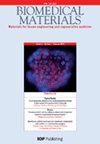LBL assembly of Ag@Ti3C2T X and chitosan on PLLA substrate to enhance antibacterial and biocompatibility
IF 3.7
3区 医学
Q2 ENGINEERING, BIOMEDICAL
引用次数: 2
Abstract
Poly L-lactic acid (PLLA) is a non-toxic, biocompatible degradable polymer material with excellent mechanical properties after moulding. However, it faces challenges in the use of biomedical materials because of its intolerance to bacteria. Here, we use an easy-to-operate method to prepare a composite multilayer membrane: PLLA membrane was used as substrates to assemble positively charged chitosan and negatively charged Ag@MXene on the surface using the layer-by-layer (LBL) method. The assembly process was detected by fluorescein isothiocyanate-labelled chitosan and the thickness of the coating multilayer was also detected as 210.0 ± 12.1 nm for P-M membrane and 460.5 ± 26.5 nm for P-Ag@M membrane. The surface self-assembled multilayers exhibited 91.27% and 96.11% growth inhibition ratio against Escherichia coli and Staphylococcus aureus strains under 808 nm near-infrared laser radiation with a synergistic photothermal antibacterial effect. Furthermore, best biocompatibility of P-M and P-Ag@M membranes compare to PLLA membrane motivated us to further explore its application in biomedical materials.的LBL组件Ag@Ti3C2TX和壳聚糖在PLLA基质上增强抗菌性和生物相容性
聚L-乳酸(PLLA)是一种无毒、生物相容的可降解聚合物材料,成型后具有优异的力学性能。然而,由于其对细菌的不耐受性,它在生物医学材料的使用方面面临挑战。在这里,我们使用一种易于操作的方法来制备复合多层膜:以PLLA膜为基底组装带正电荷的壳聚糖和带负电荷的壳多糖Ag@MXene使用逐层(LBL)方法在表面上。用异硫氰酸荧光素标记的壳聚糖检测组装过程,P-M膜的多层涂层厚度为210.0±12.1nmP-Ag@M膜表面自组装多层膜在808nm近红外激光辐射下对大肠杆菌和金黄色葡萄球菌的生长抑制率分别为91.27%和96.11%,具有协同的光热抗菌作用。此外,P-M和P-Ag@M膜与PLLA膜的比较促使我们进一步探索其在生物医学材料中的应用。
本文章由计算机程序翻译,如有差异,请以英文原文为准。
求助全文
约1分钟内获得全文
求助全文
来源期刊

Biomedical materials
工程技术-材料科学:生物材料
CiteScore
6.70
自引率
7.50%
发文量
294
审稿时长
3 months
期刊介绍:
The goal of the journal is to publish original research findings and critical reviews that contribute to our knowledge about the composition, properties, and performance of materials for all applications relevant to human healthcare.
Typical areas of interest include (but are not limited to):
-Synthesis/characterization of biomedical materials-
Nature-inspired synthesis/biomineralization of biomedical materials-
In vitro/in vivo performance of biomedical materials-
Biofabrication technologies/applications: 3D bioprinting, bioink development, bioassembly & biopatterning-
Microfluidic systems (including disease models): fabrication, testing & translational applications-
Tissue engineering/regenerative medicine-
Interaction of molecules/cells with materials-
Effects of biomaterials on stem cell behaviour-
Growth factors/genes/cells incorporated into biomedical materials-
Biophysical cues/biocompatibility pathways in biomedical materials performance-
Clinical applications of biomedical materials for cell therapies in disease (cancer etc)-
Nanomedicine, nanotoxicology and nanopathology-
Pharmacokinetic considerations in drug delivery systems-
Risks of contrast media in imaging systems-
Biosafety aspects of gene delivery agents-
Preclinical and clinical performance of implantable biomedical materials-
Translational and regulatory matters
 求助内容:
求助内容: 应助结果提醒方式:
应助结果提醒方式:


